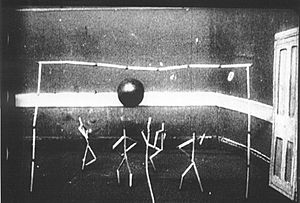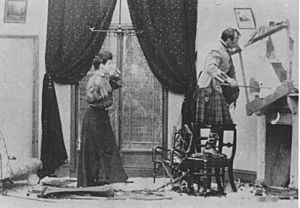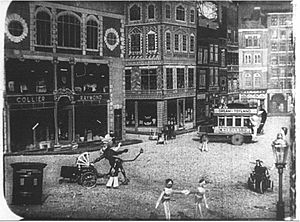Arthur Melbourne-Cooper facts for kids
Quick facts for kids
Arthur Melbourne Cooper
|
|
|---|---|
| Born | 15 April 1874 |
| Died | 28 November 1961 (aged 87) Coton, England, United Kingdom
|
| Occupation |
|
| Spouse(s) |
|
| Children |
|
Arthur Melbourne Cooper (born April 15, 1874 – died November 28, 1961) was a British photographer and one of the very first filmmakers. He is famous for being a pioneer in a special movie-making technique called stop-motion animation.
He made over 300 films between 1896 and 1915. About 36 of these films used animation, either fully or in part. Some of his well-known animated films include Dreams of Toyland (1908). Some people also believe he made Dolly’s Toys (1901) and Matches: An Appeal. It's even thought that Matches: An Appeal might have been the first animated film ever shown to the public!
After he passed away, film historians have discussed some parts of his career. There are different ideas about his work with another film pioneer, Birt Acres. Also, some films, like the "GRG-Series," are usually given credit to George Albert Smith, but some researchers think Arthur Melbourne Cooper made them. The exact date of his film Matches: An Appeal is also debated. These discussions have been going on for many years among experts.
Contents
Arthur Melbourne Cooper's Life and Work
Starting Out in Film
Arthur Melbourne Cooper was born in St Albans, England. His father, Thomas M. Cooper, was a photographer, and he taught Arthur all about photography from a young age. By the time Arthur was 16, he was helping out at his father's photography shop.
Arthur later said he started working for film pioneer Birt Acres in 1892. However, some historians think this might not be quite right because Birt Acres himself was still working for another company until 1895.
In the late 1890s and early 1900s, Cooper often filmed important events very quickly. He would film and develop the footage fast so people could see it soon after it happened. For example, he filmed the launch of a boat called the Albion in 1898. He also filmed the crowning of King Edward VII in 1902 and the famous horse race, the 1903 Grand National.
Some researchers, like Tjitte de Vries from the Netherlands, believe that Cooper also made the Animated Matches films during this time. These films are usually thought to be from 1914, but some think they are much older. Tjitte de Vries also believes Cooper made the "GRG-Series" of films, which are usually credited to George Albert Smith.
After his father died in 1901, Arthur started thinking about creating his own film company.
The Alpha Trading Company
By 1906, Cooper had started his own company called the Alpha Trading Company. He began making his own films. One of his films from this time was MacNab's Visit to London (1905). In this funny movie, he played a character named MacNab in a silly golf comedy. He also made The Motor Pirate (1906), a film about bandits in an armored car. In 1906, he also helped start the British Kinematograph Manufacturers Association, a group for film makers.
In 1907, Cooper made a very long film called London to Killarney. He filmed it from a special car attached to the front of a train. This film was about 3,000 feet long, which was very long for that time! It was released in four parts. After filming the train ride, he also made a comedy called Irish Wives and English Husbands (1907) in Ireland. This was the first story-based film ever made in Ireland.
By 1908, Cooper had set up the Alpha Production Works in St Albans. During this time, he made Dreams of Toyland (1908). This is one of his earliest animated films that everyone agrees he made. It used stop-motion animation and featured themes and characters he would use again. Some earlier animated films, like Dolly’s Toys (1901) and the Animated Matches films, are also sometimes credited to him, but their dates and who made them are still debated.
The Alpha Picture House
On July 27, 1908, Cooper opened the Alpha Picture House in St Albans. This was the first permanent movie theater in Hertfordshire. It was a very modern building for its time, with a restaurant, a swimming pool, and even a hair salon! The cinema itself had 800 seats and was considered one of the first cinemas like we know them today.
However, after a new law about cinemas was passed in 1910, the Alpha Picture House didn't pass inspection. Cooper had to sell it the next year. The cinema continued to operate under a new name, the Poly, until 1926. It was sadly destroyed by fire the following year. A new cinema was built on the same spot and stayed open until the 1990s. Today, it has been restored and is known as The Odyssey Cinema.
In 1909, Cooper went to Paris to represent his Alpha Trading Company at the first international film meeting. He wanted to make sure film producers had their rights protected. That same year, he opened a second movie theater in Letchworth. But this one wasn't as successful because many people in that town preferred going to church over watching movies. Two fires at this cinema caused Cooper serious money problems.
Kinema Industries Ltd
After 12 years, Cooper closed his businesses in St Albans. He moved with his family to Manor Park, Lee. Here, he made amazing puppet animation films for a company called Butcher's Empire Films. Their studios were right behind his garden! One of his most beautiful animated films was Cinderella (1912), which was even released in hand-colored versions. For a while, Cooper also managed a new cinema in Harrow to help pay off his debts.
Cooper then started two new companies: Heron Films Ltd. and Kinema Industries Ltd. Heron Films made longer movies, like comedies and dramas, often working with a famous actor named Mark Melford. Kinema Industries Ltd. made documentaries and newsreels. One famous newsreel was The Suffragette Derby from 1913. This film showed a suffragette (a woman fighting for the right to vote) named Emily Davison being accidentally trampled by the King's racehorse at Epsom. Cooper filmed it himself, and his brother filmed it from another spot.
Both companies closed when the First World War began because many people, including his business partner, went to serve in the war. Cooper then became a munition inspector, checking weapons in Luton.
After the First World War, Cooper and his family moved to Blackpool. He became a manager for Animads, a company that made animated advertisements. He created animated commercials for products like Cadbury's chocolates, Paddy Whiskey, Swiss Rolls, and a "Clean Milk Campaign."
Later Life
Arthur Melbourne Cooper retired in 1940. He moved to Coton, Cambridgeshire, where he passed away in 1961. He is buried in the cemetery of St Peter's Church in Coton, next to his wife.
His Lasting Impact
In 1955, Cooper's daughter, Audrey Wadowska, visited a film history exhibition. She saw pictures from a series of films that were credited to George Albert Smith. But Audrey recognized her own family members in the pictures! She believed her father must have filmed them. This group of films is known as the "GRG-Series," named after Grandma's Reading Glass (1900). This particular film was important because it was one of the first to use a "close-up" shot.
Audrey campaigned to have these films recognized as her father's work. A Dutch researcher, Tjitte de Vries, supported her. Because of their efforts, the Museum of Modern Art Film Archive in New York now credits these films to Cooper. However, other film archives, like the BFI National Film and Television Archive, still credit them to George Albert Smith.
Tjitte de Vries also supports the claim that Cooper's animated films, like Matches: An Appeal, were made in 1899, not 1914. If this is true, it would mean Cooper used stop-motion animation earlier than anyone else known!
In 1996, the city of St Albans and the British Film Institute put up a special plaque. It's on a building where Cooper's Alpha Cinematograph Works used to be. This was to celebrate 100 years of British films and remember Cooper's important work. Even though the original cinema he built burned down, a new one was built on the same spot. It was known by different names over the years, like the Regent and the Odeon, and stayed open until 1995. In 2014, the building was restored and reopened as The Odyssey Cinema.
Images for kids









